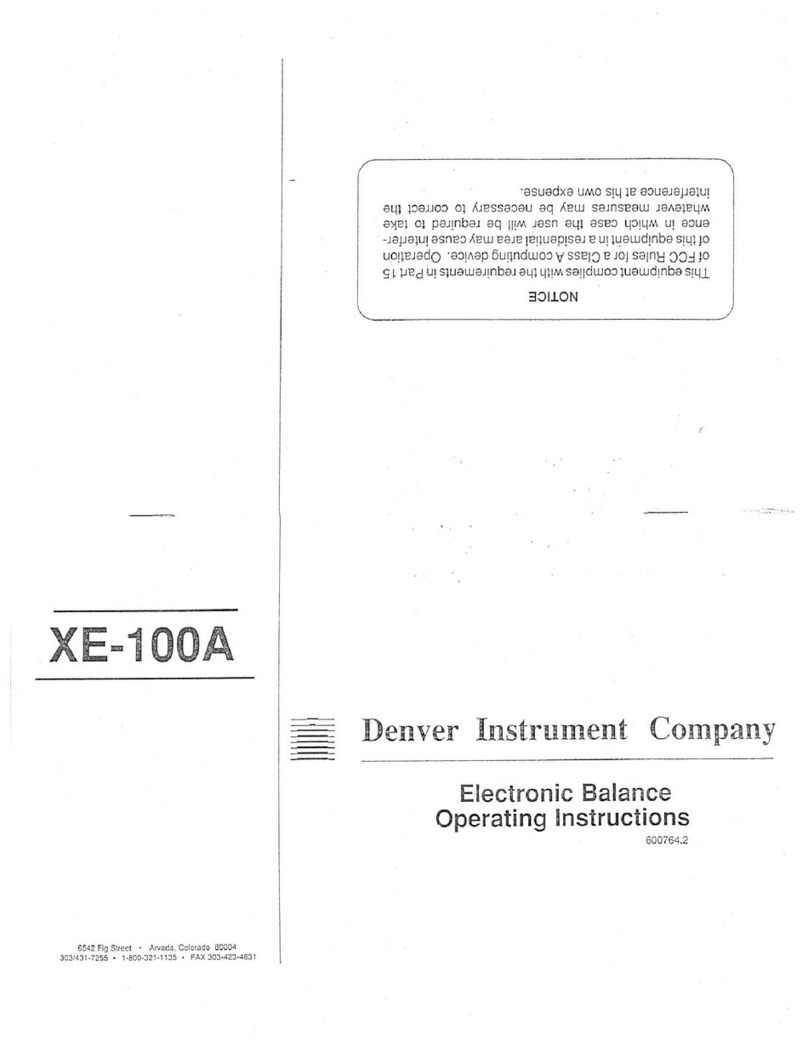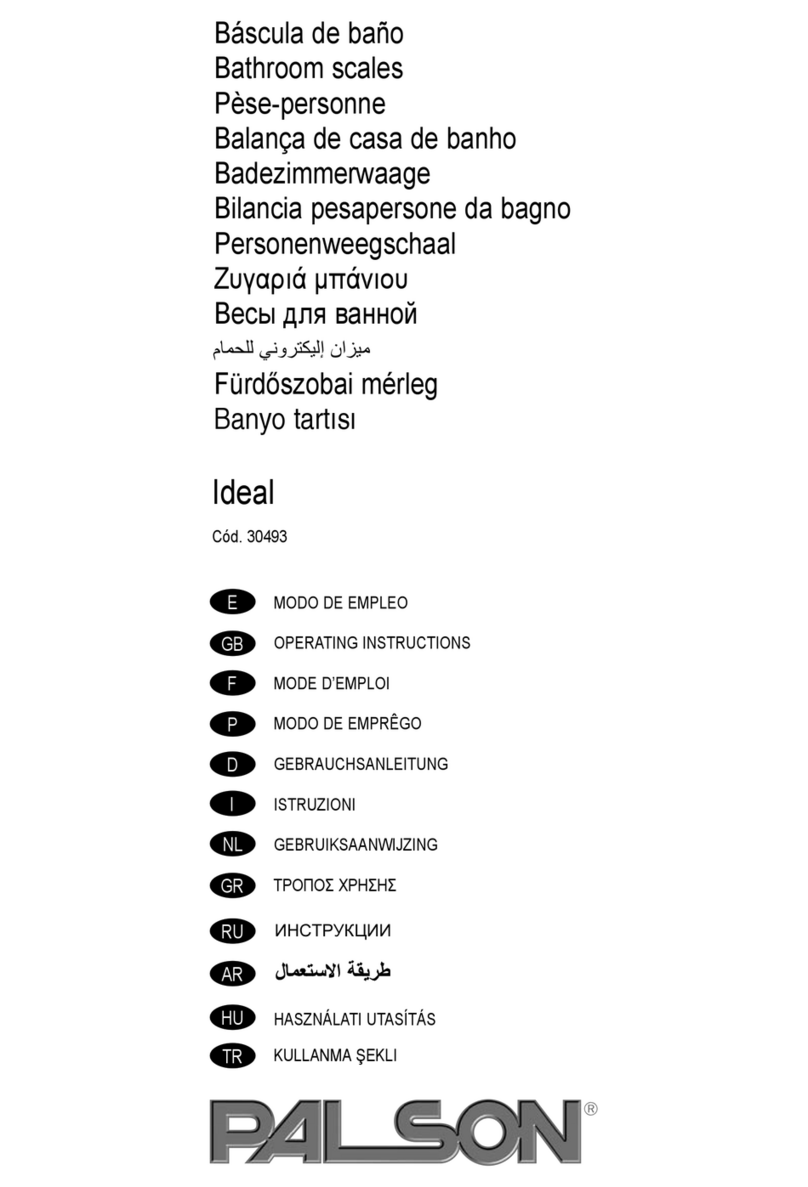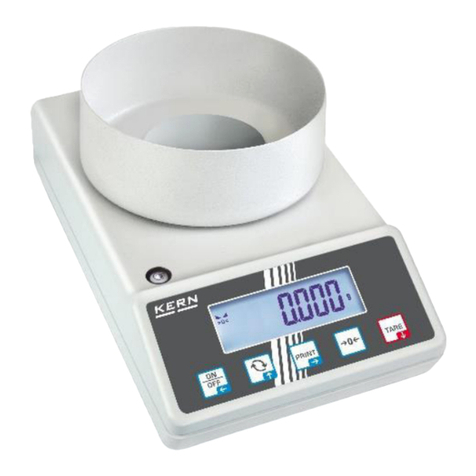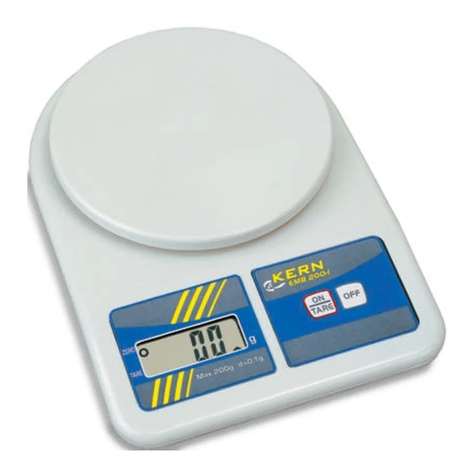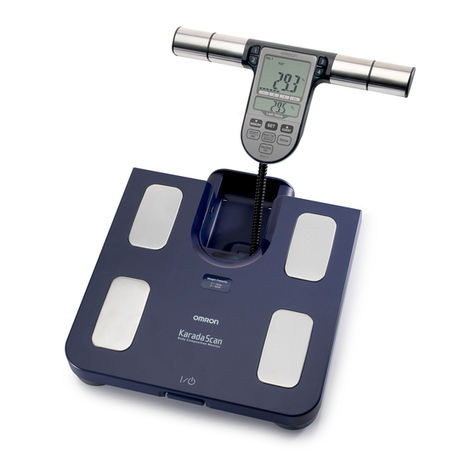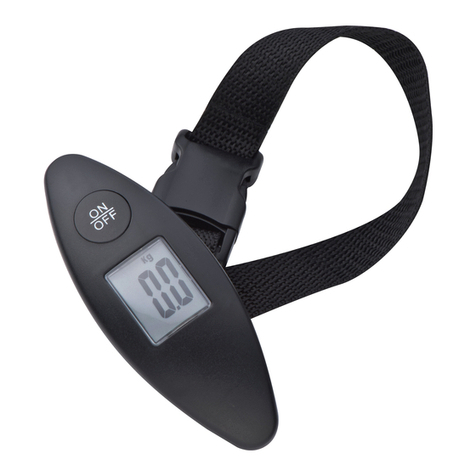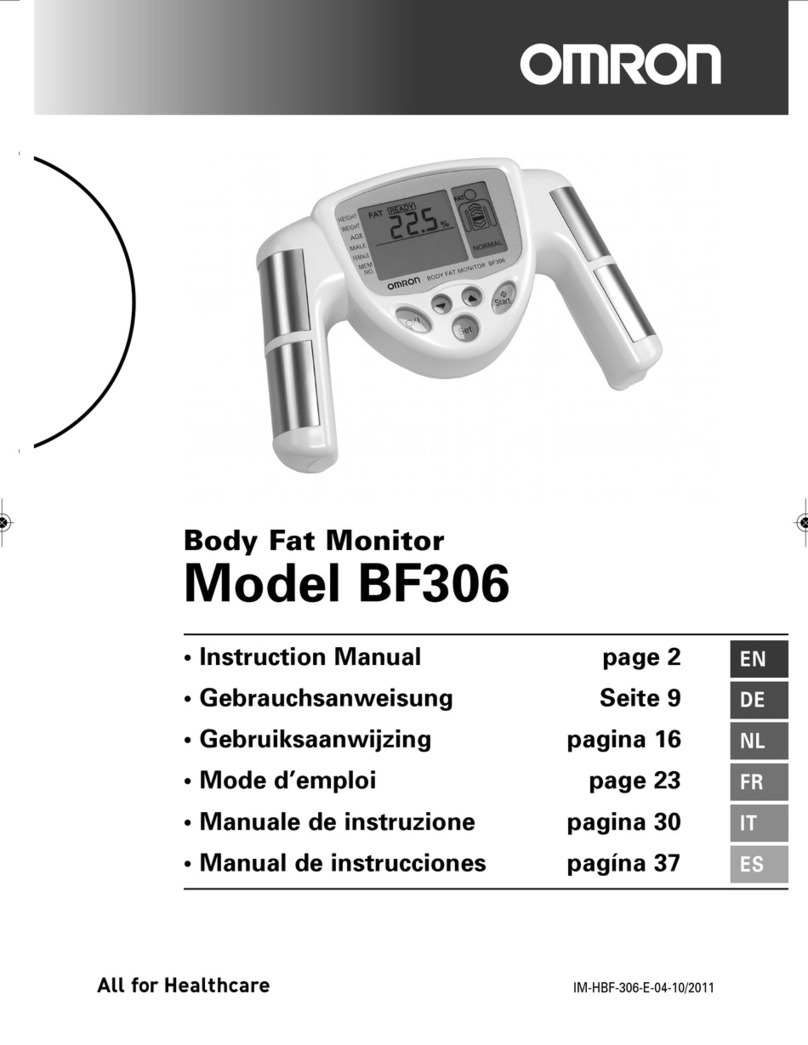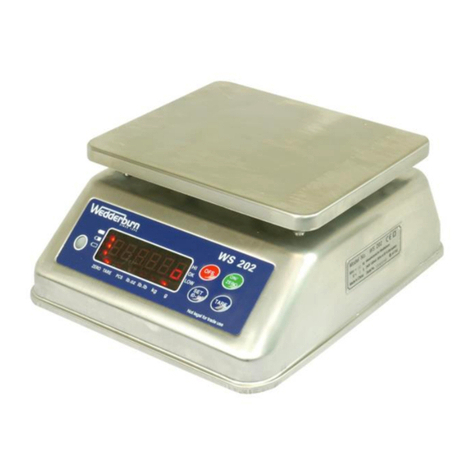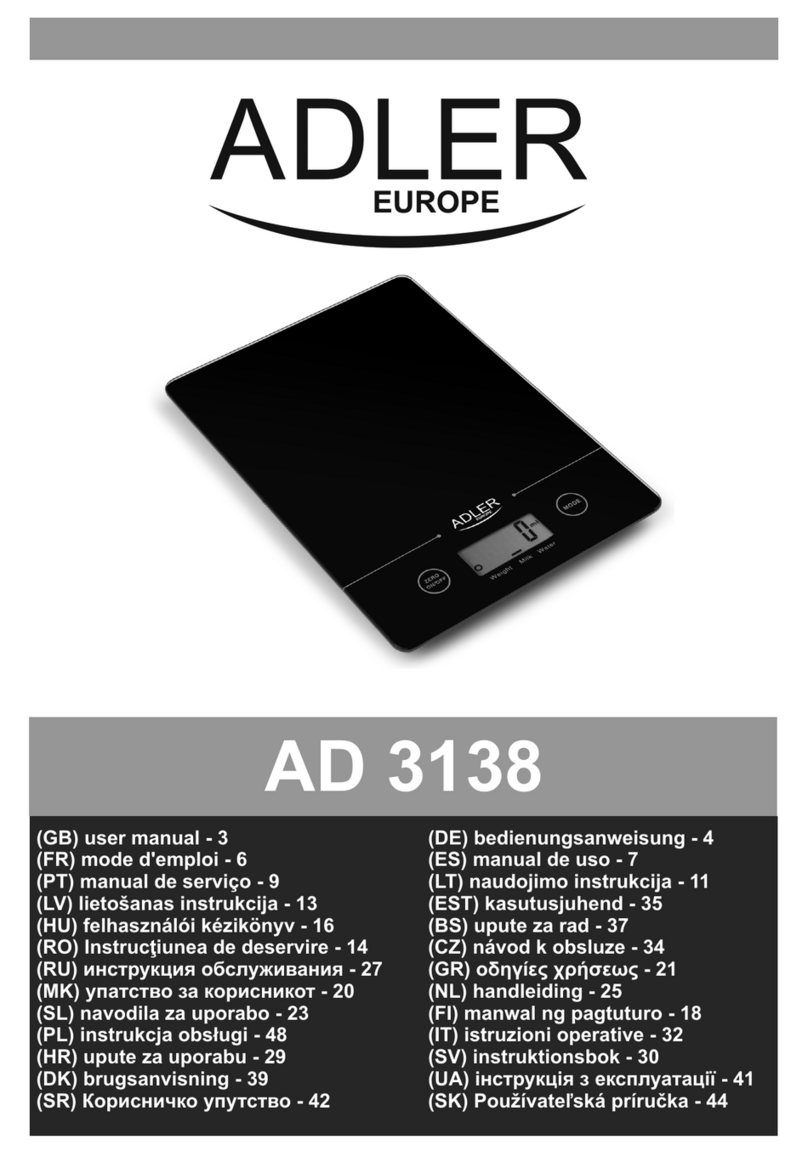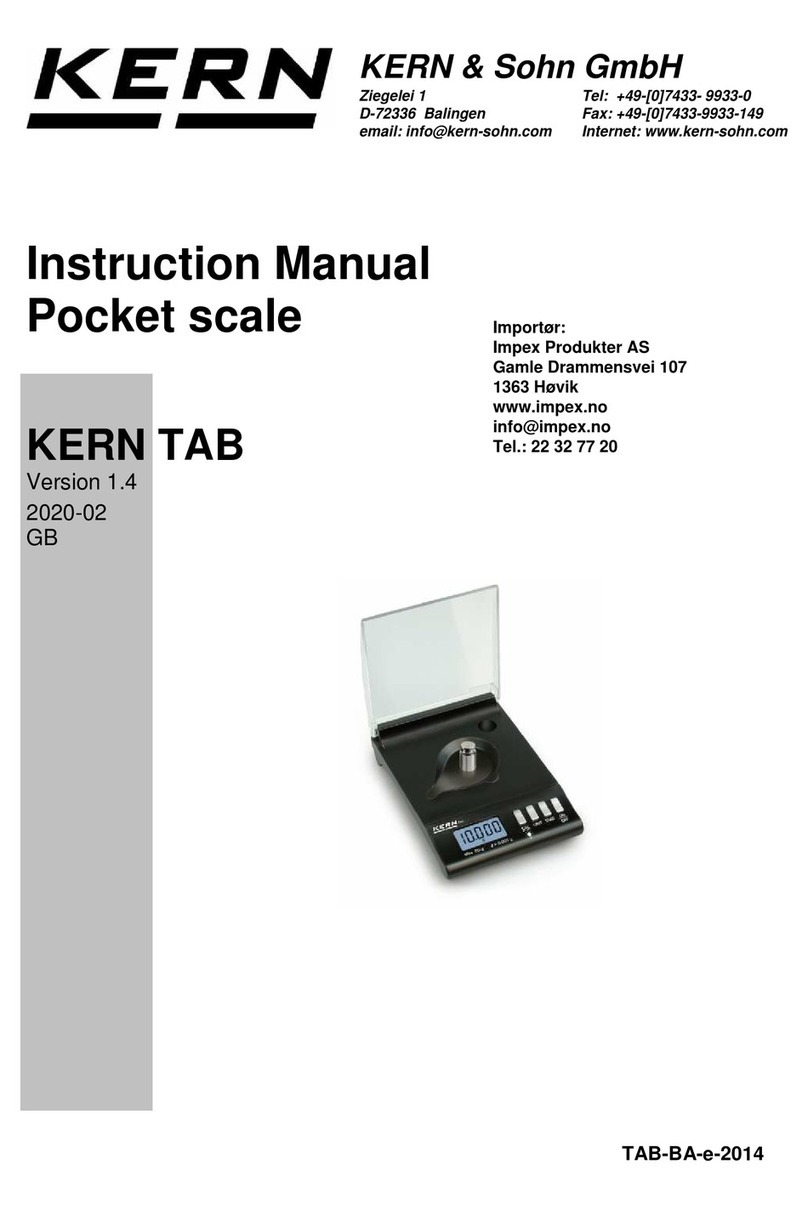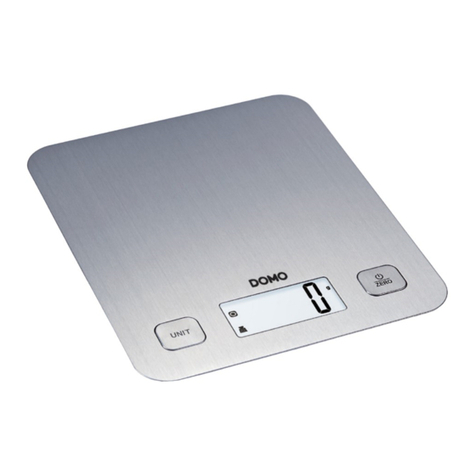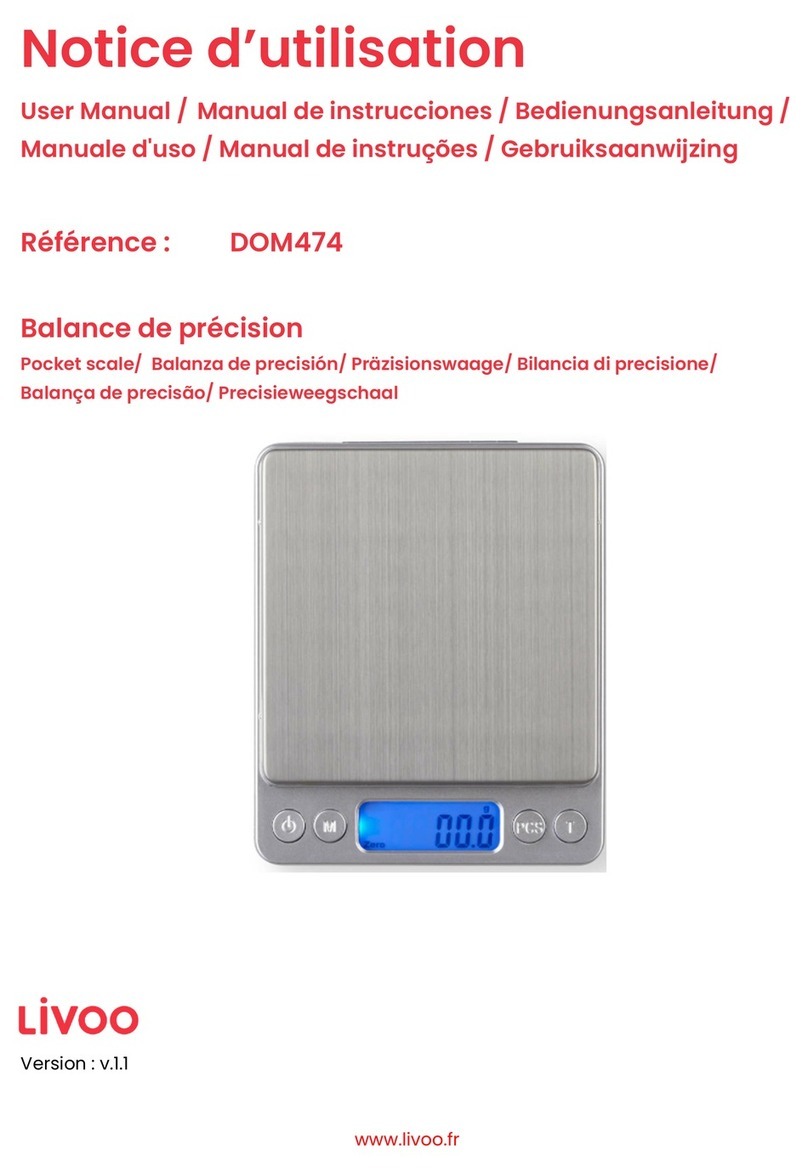Denver Instrument MAXX User manual

Denver MAXX
Electronic Precision Scales/Balances
Elektronische Präzisionswaagen
Balances électroniques d’analyse et de précision
Balanzas electrónicas de precisión
Operating Instructions/Betriebsanleitung/
Mode d’emploi/Manual de instrucciones

English page 3
In cases involving questions of
interpretation, the German-language
version shall prevail.
Deutsch Seite 20
Im Auslegungsfall ist die
deutsche Sprache maßgeblich.
Français page 37
En cas de questions concernant
l’interprétation, la version
en langue allemande fera autorité.
Español página 54
En caso de interpretación,
la versión en lengua alemana
será determinante.
2

3
Contents
Page
Warnings and Safety Precautions . . . . . . . . . . . . . . . . . . . . . . . . . . . . . . . . . . . . . 4
Getting Started. . . . . . . . . . . . . . . . . . . . . . . . . . . . . . . . . . . . . . . . . . . . . . . . . . . . . 5
Operation . . . . . . . . . . . . . . . . . . . . . . . . . . . . . . . . . . . . . . . . . . . . . . . . . . . . . . . . . 8
Basic Weighing Function . . . . . . . . . . . . . . . . . . . . . . . . . . . . . . . . . . . . . . . . . . . 8
Description of the Keys. . . . . . . . . . . . . . . . . . . . . . . . . . . . . . . . . . . . . . . . . . . . . 8
Application Programs . . . . . . . . . . . . . . . . . . . . . . . . . . . . . . . . . . . . . . . . . . . . . . . 9
Toggling between Weigh Units . . . . . . . . . . . . . . . . . . . . . . . . . . . . . . . . . . . . . . 9
Counting . . . . . . . . . . . . . . . . . . . . . . . . . . . . . . . . . . . . . . . . . . . . . . . . . . . . . . . . . 10
Weighing in Percent . . . . . . . . . . . . . . . . . . . . . . . . . . . . . . . . . . . . . . . . . . . . . . . 11
Display Lock Mode . . . . . . . . . . . . . . . . . . . . . . . . . . . . . . . . . . . . . . . . . . . . . . . . 12
Total/Formulation . . . . . . . . . . . . . . . . . . . . . . . . . . . . . . . . . . . . . . . . . . . . . . . . . 13
Specific Gravity . . . . . . . . . . . . . . . . . . . . . . . . . . . . . . . . . . . . . . . . . . . . . . . . . . . 14
Calibration/Span Adjustment . . . . . . . . . . . . . . . . . . . . . . . . . . . . . . . . . . . . . . . . . 15
Advanced Features (Setup Menu) . . . . . . . . . . . . . . . . . . . . . . . . . . . . . . . . . . . . . 16
Error Codes. . . . . . . . . . . . . . . . . . . . . . . . . . . . . . . . . . . . . . . . . . . . . . . . . . . . . . . . 17
Overview. . . . . . . . . . . . . . . . . . . . . . . . . . . . . . . . . . . . . . . . . . . . . . . . . . . . . . . . . . 18
Specifications. . . . . . . . . . . . . . . . . . . . . . . . . . . . . . . . . . . . . . . . . . . . . . . . . . . . . 18
Accessories . . . . . . . . . . . . . . . . . . . . . . . . . . . . . . . . . . . . . . . . . . . . . . . . . . . . . . 19
CMarking . . . . . . . . . . . . . . . . . . . . . . . . . . . . . . . . . . . . . . . . . . . . . . . . . . . . . . . 19

4
Installation
– It is recommended to connect
only Denver accessories and
options, as these are optimally
designed for use with your
balance/scale.
– Do not open the balance/scale
housing as this will void the
manufacturer’s warranty.
Symbols
The following symbols are used
in these instructions:
●indicates steps you must
perform
$indicates steps you must
perform only under certain
conditions
>describes what happens after
you have performed a certain
step
–indicates an item in a list
!indicates a hazard
Warnings and Safety Precautions
Safety Information
●To prevent damage to the equip-
ment, please read these operat-
ing instructions carefully before
using your balance/scale.
!Do not use this equipment in
hazardous areas.
!Make sure the voltage rating
printed on the power supply is
identical to your local line volt-
age.
!Use only commercially available
9V batteries (not included).
If desired, you can use a
rechargeable battery.
– The balance/scale is energized at
all times unless you disconnect
the AC adapter and, if connect-
ed, the battery.
– Protect the AC adapter from
contact with liquid
!Exposure to excessive electro-
magnetic interference can cause
the readout value to change.
Once the disturbance has
ceased, the instrument can be
used again in accordance with
its intended purpose.

5
Getting Started
Equipment Supplied
– Balance/scale
– Weighing pan
– AC adapter
Additional equipment with models
MXX-612, MXX-412, MXX-212:
– Calibration weight
Additional equipment with model
MXX-123:
– Calibration weight
– Round glass draft ring
– Level indicator and adjustable feet
Installation
Choose a location that is not subject
to the following negative influences:
– Heat (heater or direct sunlight)
– Drafts from open windows and
doors
– Extreme vibrations during
weighing
– Excessive moisture
Setting Up the Balance/Scale
●Place the components on the
balance/scale in the following
order:
– Reversible weighing pan
– Round glass draft ring on model
MXX-123

6
Connecting the Balance/Scale
to AC Power
!Use only the AC adapter for
optimal performance and safety.
§Insert plug into the jack (located
on back of balance/scale)
§Plug the AC adapter into an
electrical outlet
!LISTED power supply 11 V–21 V
compliant with NEC Class 2 out-
put.
Below-Balance/Under-Scale Weighing
A port for a below-balance weighing
hanger is located on the bottom of
the balance/scale.
§Open the cover plate on the
bottom of the balance/scale.
§Attach the sample (e.g., using
a suspension wire) to the hanger.
$Install a shield for protection
against drafts if necessary.
Installing the Battery
(not for model MXX-123)
$Batteries are not included with
the equipment supplied
!Use only commercially available
9V batteries.
!If you use a rechargeable bat-
tery, recharge it with an external
battery charger.
§Lay the balance/scale on its side
§Open the battery compartment:
remove the compartment cover
§Install the battery in the com-
partment
$Make sure the polarity is correct.
§Close the battery compartment:
slide the cover into position until
it snaps into place
!Do not throw away used batter-
ies with normal household
waste. Rechargeable batteries
contain toxic materials and must
be disposed of in accordance
with local waste disposal regula-
tions.

7
Leveling the Balance/Scale
(only for model MXX-123)
§Always level the balance/scale
again any time after it has been
moved to a different location.
§Turn the front feet as shown in the
diagram until the air bubble is cen-
tered within the circle of the level
indicator.
§Lower all feet to touch the counter-
top so the balance/scale does not
rock.
> In most cases this will require
several adjustment steps.
Removing Weights for
Calibration/Span Adjustment
(only for models MXX-612, MXX-412,
MXX-212, MXX-123)
§Grasp the tab to turn and pull out
the weight compartment.
§Always wear gloves or use tweez-
ers when handling weights.
$Follow instructions on page 15 for
calibration/span adjustment.
Warmup Time for Model MXX-123:
To ensure accurate results, the scale
must warm up for 1 hour before
operation. Only after this time will
the scale have reached the required
operating temperature.

Operation
Basic Weighing Function
Features
– Zeroing the balance/scale
You can zero the balance/scale with-
in the entire weighing range, up to
the maximum capacity.
Preparation
§Switch on the balance/scale:
press the (ON/OFF) key
§If necessary, zero the balance/
scale: press the (ZERO) key
$If necessary, change the configura-
tion settings: see the chapter
entitled “Configuration”
$If desired, reset the factory settings:
see the chapter entitled
“Advanced Features,” menu item
9.– 1
Additional functions:
$Switching off the balance/scale:
press the (ON/OFF) key
$Battery operation: automatic shut-off
after 2, 5 or 10 minutes; see chapter
on configuration. Example: 2 min-
utes. If the weight readout remains
unchanged and no keys are pressed
for at least two minutes, the battery
symbol “ “ starts flashing.
After another 2 seconds, the
balance/scale shuts off automati-
cally, unless a key is pressed.
Description of the Keys
(ON/OFF) On/off key: switches the
balance/scale on and off or
switches it to the standby
mode.
Battery operation: on;
turns backlight on; off
(ZERO) Zeros the balance/scale;
press and hold 2 seconds:
enters application menu
(CAL) Starts calibration/adjust-
ment
(F) Starts an application pro-
gram; scrolling in applica-
tion menu, configuration
menu and calibration menu
(ENTER) Confirms the selected
setting; exits application,
configuration & calibration
menu if key is pressed
and held for at least
2 seconds.
(PRINT) Generates a printout or
data output
Example: Determine weight of sample
Step Key (or instruction) Display
1. Switch on the balance/scale (ON/OFF)
Self-test runs
Display: Software version r 31.01 g
2. Place container on the balance/scale
(in this example, 52 g) 52.0 g
3. Zero the balance/scale (ZERO) 0.0 g
4. Place sample in container on
balance/scale (in this example, 150.2 g). 150.2 g
8

9
Application Programs
Toggling between Weigh Units
With this application program you can toggle the display of a weight value
back and forth between two weigh units (see table below).
Example: Toggle weigh unit from pounds [lb] (application) to grams [g]
(basic unit)
Step Key (or instruction) Display
1. Select application program (ZERO) ≥2 sec
2. Select Toggling between Weigh Units (F) repeatedly
3. Confirm unit of application* (ENTER)
4. Select weigh unit; in this example: (F) repeatedly
“5. Pounds” (see table below)
5. Confirm weigh unit (pounds) (ENTER)
6. Place sample on balance/scale
7. Toggle weigh unit (F)
Menu code Unit Conversion factor Display
1. user** Grams 1.00000000000 o
2.grams (factory setting) Grams 1.00000000000 g
4.carat Carats 5.00000000000 o
5.Pound Pounds 0.00220462260 lb
6.ounce Ounces 0.03527396200 oz
7.tryo Troy ounces 0.03215074700 ozt
8.tl.hon Hong Kong taels 0.02671725000 tlk
9.tl.sin Singapore taels 0.02645544638 tl
10.tl.ta Taiwanese taels 0.02666666000 tl
11.grai Grains 15.4323583500 GN
12.peny Pennyweights 0.64301493100 dwt
15.tl.ch Chinese taels 0.02645547175 tl
22.pdoz lb/oz 0.03527396200 lb:oz
23.ne t Newtons 0.00980665000 N
* Grams is chosen as 1st unit; to changes 1st unit, see Advanced Features section.
** User-defined conversion can be loaded in balance/scale with RS-232 or USB
program option. Contact Denver Instrument for more information.

10
Counting
Purpose
With the Counting program you can determine the number of parts or pieces
by weight.
Example: Determine the number of uncounted parts; calculate the sample
reference quantity (in this example: 20)
Step Key (or instruction) Display
1. Select application program (ZERO) ≥2 sec
2. Select Counting (F) repeatedly
3. Confirm application (ENTER)
Symbol “ “ on the display:
application is active
4. Place empty container on the
balance/scale
5. Zero the balance/scale (ZERO)
6. Place sample reference quantity (20)
on the balance/scale
7. Select sample reference quantity:
in increments of 1 (1, 2, 3, ..., 99) or (F) repeatedly (briefly) or
in increments of 10 (10, 20, 30, ...,100) (F) ≥2 sec.
8. Confirm selected sample reference
quantity (ENTER)
9. Place uncounted parts on balance/scale
10. Toggle display between mean
piece weight, total weight, and quantity (F) repeatedly
11. Unload the balance/scale
12. Start new Count application
or exit application (ENTER) ≥2 sec
13. Reactivate Counting (if no other (F)
application program has been selected)
14. Repeat procedure starting from Step 5.

11
Purpose
This application program allows you to obtain weight readouts in percent
which are in proportion to a reference weight.
Example: Determine an unknown percentage; store the weight on the
balance/scale as the reference percentage (100%)
Step Key (or instruction) Display
1. Select application program (ZERO) ≥2 sec
2. Select Weighing in Percent (F) repeatedly
3. Confirm application (ENTER)
Symbol “ “ on the display:
application is active
4. Place empty container on the
balance/scale
5. Zero the balance/scale (ZERO)
6. Place the reference weight
for 100% on the balance/scale
7. If desired, change the number
of decimal places displayed: 100.0%,
100.00% or 100% (factory setting) (F) repeatedly
8. Confirm selected no. of decimal places (ENTER)
9. Place unknown weight on the
balance/scale
10. Toggle display between weight
and percentage (F) repeatedly
11. Unload the balance/scale
12. Start new Weighing in Percent
application or exit application (ENTER) ≥2 sec
13. Reactivate Weighing in Percent
(if no other application program
has been selected) (F)
14. Repeat procedure starting from Step 5.
Weighing in Percent

12
Display Lock Mode
Purpose
The last stable value remains displayed for 5 seconds after removing the
sample from the pan.
Example: Determine weight of oversized sample
Step Key (or instruction) Display
1. Select application program (ZERO) ≥2 sec
2. Select Display Lock (“HLdon”) (F) repeatedly
3. Confirm application (ENTER)
Symbol “ ” on the display:
application is active
4. If necessary: zero the balance/scale (ZERO)
5. Place sample on balance/scale
6. Start application program (F)
Symbol “ ” flashes on the display:
when stability conditions are met
7. Unload the balance/scale:
the weight value remains displayed
for a further 5 seconds; or
8. Zero the balance/scale (ZERO)
9. End the Display Lock application (ENTER) ≥2 sec
10. Reactivate Display Lock (if no other (F)
application program has been selected)
11. Repeat procedure starting from Step 5.

13
Purpose
With this application program you can add successive weight values. The
cumulative weight can infinitely exceed the capacity of the balance/scale.
Example: Obtaining the total/formulation
Step Key (or instruction) Display
1. Select application program (ZERO) ≥2 sec
2. Select Total (formulation) (F) repeatedly
3. Confirm application (ENTER)
Symbol “ “ on the display:
application is active
4. If necessary: zero the balance/scale (ZERO)
5. Place sample on balance/scale
(in this example, 380 g)
6. Store value in memory. (ENTER)
Total weight is displayed
steadily; ∑symbol flashes.
If interface is connected, sample
weight is outputted automatically
7. Remove sample or press ZERO
8. Place the next sample
on the balance/scale
(in this example, 575 g)
9. Store value in memory. Total weight is (ENTER)
displayed; along with the flashing ∑icon.
Note: ∑symbol remains on, indicating
stored value in memory until cleared
(if interface is connected, sample weight
is outputted automatically).
10. To view current individual weight for (F)
2 seconds (if a printer is connected,
a printout is generated)
11. Clear Total memory (F) ≥2 sec
(if a printer is connected, total is printed)
12. Exit Total/Formulation (ENTER) ≥2 sec
13. Reactivate Totalizing (if no other (F)
application program has been selected)
(if a printer is connected, total is printed).
14. Repeat procedure starting from Step 6.
Total/Formulation

14
Purpose
Use this application program to determine the specific gravity of a sample.
The calculation used is Result = Weight in air/(Weight in air – Weight in water).
The result is displayed with one decimal place.
Beaker and wire not included with balance/scale.
Example: Determine the specific gravity of a solid.
Step Key (or instruction) Display
1. Select application program (ZERO) ≥2 sec
2. Select Specific Gravity (F) repeatedly
3. Confirm application (ENTER)
Symbol “ “ on the display:
application is active
4. If necessary, zero the balance/scale (ZERO)
5. Start application program (F)
6. Confirm the display, “airval” (ENTER)
7. Determine weight of the sample in air:
place sample on the balance/scale
8. Store weight-in-air value (ENTER)
9. Remove sample from balance/scale
10. Determine weight of sample in liquid:
connect wire and set up beaker
11. Confirm the display “Water” (ENTER)
12. Place sample in liquid
13. Store the weight-in-liquid value
and view the result (ENTER)
14. Clear the display (ZERO)
15. Exit the Specific Gravity application (ENTER) ≥2 sec
16. Reactivate Specific Gravity (if no other (F)
application program has been selected)
17. Repeat procedure starting from Step 5.
Specific Gravity

15
Calibration/Span Adjustment
Calibration is recommended after initial installation and each time the bal-
ance/scale is moved.
The weight required for calibration/
span adjustment is displayed.
Standard calibration weights for
selected models: to remove, see
instructions on page 7.
Press (F) to select a different weight
value.
To cancel the procedure: press and
hold the (ENTER) key (≥2 sec.).
Features
Calibration/adjustment can be
performed only when:
– there is no load on the balance/scale,
– the scale is zeroed, and
– the internal signal is stable.
If these conditions are not met, an
error message is displayed.
Example: Calibrate/adjust span of the balance/scale (here: model MXX-5001)
Step Key (or instruction) Display
1. Switch on the balance/scale (ON/OFF)
2. Zero the balance/scale (ZERO)
3. Start calibration (CAL)
The preset calibration weight
is displayed without the weigh unit
(in this example, 5000 g)
4. To select a different calibration
weight value (F) repeatedly
5. Start calibration/span adjustment (ENTER)
After the zero point is stored, the required
calibration weight flashes on the display.
6. Place the required calibration
weight on the balance/scale
The readout stops flashing if the weight
is applied within the defined time limit and
tolerance. If the weight value is accepted,
the display stops flashing and the stability
symbol appears on the display.
7. Remove the calibration weight
8. Calibration/span adjustment has
been completed

16
Purpose: Serveral advanced balance operations can be changed through menu codes. Select
the desired codes from the list below. Then follow the steps to change the menu codes.
Step Key (or instruction) Display
1. Turn balance off. (ON/OFF)
2. Turn the balance back on. While all segments ZERO
are displayed, press ZERO key once.
3. Increase the number on display to desired value. MODE
4. Move to the 2nd number of the code. ENTER
5. Increase the second number on display MODE
to desired value.
6. Move to the 3rd number of the code (when you ENTER
move to the third number, the previously set menu
code will appear).
7. Increase the third number on display to desired value. MODE
8. Confirm new code Hold down the ENTER key until ”0“ appears after
the desired code.
9. Exit setup menu. Press ZERO for more than 2 seconds
Special Keyfinctions for Menu Code Operation
Key Press briefly Press and hold
(F) Increase a number by one with each press
(ENTER) Moves to the next of three numbers of a code; hold to confirm setting
(ZERO) Moves to the previous number of a codes; hold to exit set-up.
Parameter Settings (Overview) οFactory setting
Setup 1 Weighing 1.1. Adapt filter 1.1.1 Very stable conditions
menu 1.1.2 οStable conditions
1.1.3 Unstable conditions
1.1.4 Very unstable conditions
1.2. Application filter 1.2.1 οFinal readout
1.2.2 Filling
1.3. Stability range 1.3.1 1/4 digit
1.3.2 1/2 digit
1.3.3 1 digit
1.3.4 ο2 digits
1.3.5 4 digits
1.5. Calib./adjust./linearization: 1.5.1 οCalibration/span adjustment
Function of the (CAL) key 1.5.2 Linearization: for service
personnel only
1.5.3 Key blocked
1.6. Auto zero 1.6.1 οOn
1.6.2 Off
1.7. 1st weigh unit, or 2nd unit 1.7.1 User-defined unit: see
in Toggle Weigh Units app. to 1.7.23 “Toggling between Weigh
Units”
5. and 6. Interface settings; see manual for interface accessory
8. Additional 8.1. Block key functions 8.1.1 All keys blocked except
functions (with battery use only) for (ON/OFF) and (ZERO)
8.1.2 οAll keys unblocked
8.2. Automatic shut-off 8.2.1 οAfter 2 minutes
(with battery use only) 8.2.2 After 5 minutes
8.2.3 After 10 minutes
9. Reset menu 9.1. Factory settings 9.1.1 Restore
9.1.2 οDo not restore
Advanced Features (Setup Menu)

17
Most error codes are shown on the main display for approx. 2 seconds.
The program then returns automatically to the previous mode.
Display/Problem Cause Solution
No segments appear No power available Check the power supply
on the display
The AC adapter is not plugged in Plug in the AC adapter
Battery is drained Replace battery; recharge
battery using external
charger
oL The load exceeds the Unload the balance/scale
balance/scale capacity
UL Weighing pan not in place Place the weighing pan
on the balance/scale
Something is touching Move the object that is
the weighing pan touching the weighing pan
disErr Display overflow: Reduce load on the
Value cannot be shown balance/scale
on the display
calErr Calibration parameter not met; e.g.: Calibrate only when zero
is displayed
– Balance/scale not zeroed Press (ZERO) to tare the
balance/scale
– Balance/scale is loaded Unload the balance/scale
appErr Weight is too light or there is Increase the weight
no sample on the balance/scale on the balance/scale
with application in use
PrtErr Data interface for Contact the Denver
printing is blocked customer service center
Bal.Err Balance/scale loaded or defective Unload balance/scale before
when power was turned on switching on or contact
Denver customer service*
Sep.Err Balance/scale defective Contact Denver customer
service
Max. weighing capacity The balance/scale was Place the weighing pan
is less than indicated switched on without on the balance/scale and
under “Specifications” the weighing pan in place press (ON/OFF)
The weight readout The balance/scale was not Calibrate/adjust the
is obviously wrong calibrated/adjusted before weighing balance/scale
Balance/scale not zeroed Zero the balance/scale
If any other errors occur, contact your local Denver customer service center
* This fault will appear on the display when the unit is powered on. This occurs when the electronics are no longer
within the factory set parameters. The most common cause is from objects being dropped onto the weighing pan or
from the balance itself being dropped. The balance must be returned for service.
Error Codes

18
Overview
Specifications
Model MXX-123 MXX-612 MXX-412 MXX-212
Weighing capacity g 120 610 410 210
Readability g 0.001 0.01 0.01 0.01
Tare range (subtractive) g 120 610 410 210
Linearity ≤±g 0.003 0.03 0.03 0.03
Operating temperature range 10°C to 30°C (273°K to 303°K; 50°F to 86°F)
Response time (average) s 2.5 2 2 2
Adaptation to ambient conditions By selection of 1 of 4 optimized filter levels; display update:
s 0.1–0.8 sec. (depends on filter level selected)
Calibration weight value g 100* 200* 200* 200*
Net weight, approx. kg/lb 1.2/2.6 1.35/2.9 1.35/2.9 1.2/2.6
Pan size mm/in 97/3.8 d142+130/5.6+5.1 97/3.8 d
Power source/voltage/frequency AC adapter, 230 V or 115 V, +15% to – 20%, 48–60 Hz
Power consumption (average) W 1 0.75 0.75 0.75
Hours of operation w/ 9V battery:
– Alkaline (approx.) h – 11 11 14
– Rechargeable, fully ch.
(NiMH), avg. h – 2.5 2.5 4
* = Weight included in the equipment supplied
Model MXX-5001 MXX-2001 MXX-601 MXX-10 MXX-5
Weighing capacity g 5000 2000 600 10000 5000
Readability g 0.1 0.1 0.1 1 1
Tare range (subtractive) g 5000 2000 600 10000 5000
Linearity ≤±g 0.2 0.2 0.2 2 2
Operating temperature range 10°C to 30°C (273°K to 303°K; 50°F to 86°F)
Response time (average) s 2 2 1.5 1.5 1.5
Adaptation to ambient conditions By selection of 1 of 4 optimized filter levels; display update:
s 0.1–0.8 sec. (depends on filter level selected)
Calibration weight value kg 5 2 0.2 5 5
Net weight, approx. kg/lb 1.1/2.4 1.1/2.4 1.25/2.8 1.1/2.4 1.1/2.4
Pan size mm/in 142+130/5.6+5.1
Power source/voltage/frequency AC adapter, 230 V or 115 V, +15% to – 20%, 48–60 Hz
Power consumption (average) W 1 1 0.75 0.75 0.75
Hours of operation w/ 9V battery:
– Alkaline (approx.) h 11 11 14 14 14
– Rechargeable, fully ch.
(NiMH), avg. h 2.5 2.5 4 4 4

19
Accessories
CMarking
The balance/scale complies with the
following EC Directives and European
Standards:
Council Directive 89/336/EEC
“Electromagnetic compatibility
(EMC)”
Applicable European Standards:
Limitation of emissions:
In accordance with product standard
EN 61326-1 Class B (residential area)
Defined immunity to interference:
in accordance with product standard
EN 61326-1
(minimum test requirements,
non-continuous operation)
Important Note:
The operator shall be responsible
for any modifications to Denver equip-
ment and must check and, if neces-
sary, correct these modifications.
On request, Denver will provide infor-
mation on the minimum operating
specifications (in accordance with the
Standards listed above for defined
immunity to interference).
73/23/EEC “Electrical equipment
designed for use within certain
voltage limits”
Applicable European Standards:
EN 60950
Safety of information technology
equipment including electrical busi-
ness equipment
EN 61010
Safety requirements for electrical
equipment for measurement,
control and laboratory use
Part 1: General requirements
If you use electrical equipment
in installations and under ambient
conditions requiring higher safety
standards, you must comply with
the provisions as specified in the
applicable regulations for installation
in your country.
Product Order Number
Data interface, mounting kit
– RS-232 interface with cable YADAP-RS
– USB interface with cable YADAP-USB
Data printer 901042-1
Lock-down capability
(for anti-theft locking device) 400171-1
Calibration weights
– for MXX-601 (200 g) 870200.6
– for MXX-5001 (5 kg) 875000.6
– for MXX-2001 (2 kg) 872000.6
– for MXX-10 (5 kg) 845000.4
– for MXX-5 (5 kg) 845000.4

W1A000 · KT
Publication No. WMX6001-n06075
98648-012-82
Copyright by Denver Instrument GmbH, Goettingen, Germany.
All rights reserved. No part of this publication may be reprinted
or translated in any form or by any means without the prior
written permission of Denver Instrument GmbH.
The status of the information, specifications and illustrations in
this manual is indicated by the date given below. Denver Instrument
GmbH reserves the right to make changes to the technology, fea-
tures, specifications, and design of the equipment without notice.
Status: July 2006, Denver Instrument GmbH, Goettingen,
Germany.
Europe, Asia and Australia: Denver Instrument GmbH
Robert-Bosch-Breite 10
37079 Goettingen, Germany
Tel: +49-551-20977-30
Fax: +49-551-20977-39
Internet: www.denverinstrument.com
U.K. and Ireland: Denver Instrument Company
Denver House, Sovereign Way
Trafalgar Business Park
Downham Market
Norfolk PE38 9SW England
Tel: +44-136-63862-42
Fax: +44-136-63862-04
North and South America: Denver Instrument Company
1855 Blake Street, Suite 201
Denver, Colorado 80202
1-800-321-1135
Tel: +1-303-431-7255
Fax: +1-303-423-4831
Table of contents
Other Denver Instrument Scale manuals

Denver Instrument
Denver Instrument TP Series User manual
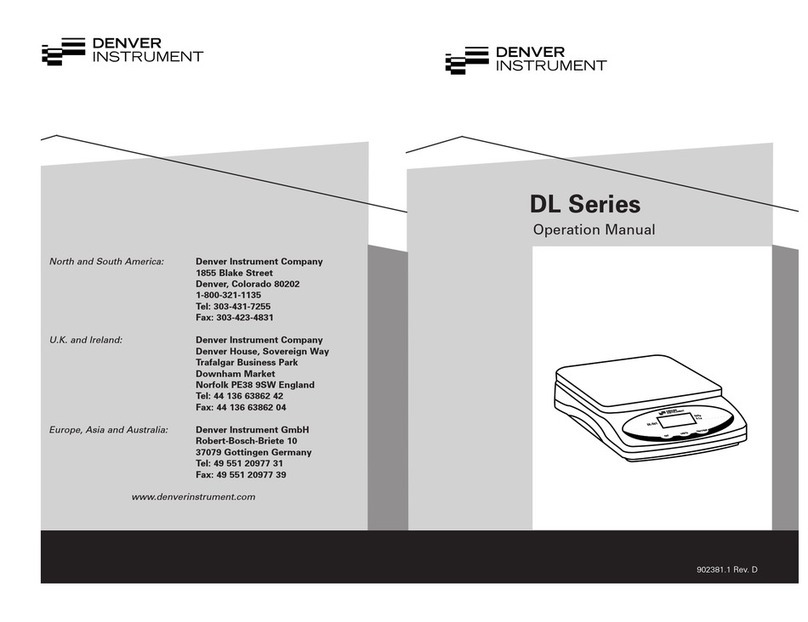
Denver Instrument
Denver Instrument DL series User manual
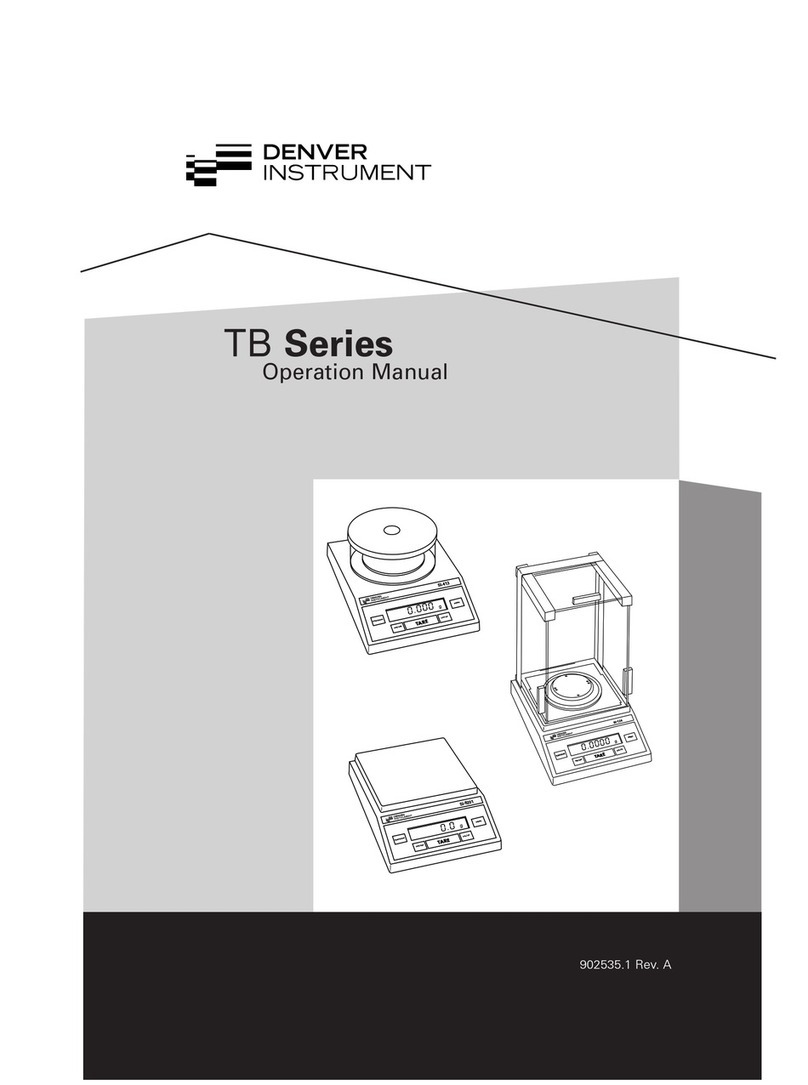
Denver Instrument
Denver Instrument TB-124 User manual

Denver Instrument
Denver Instrument Tl-series User manual
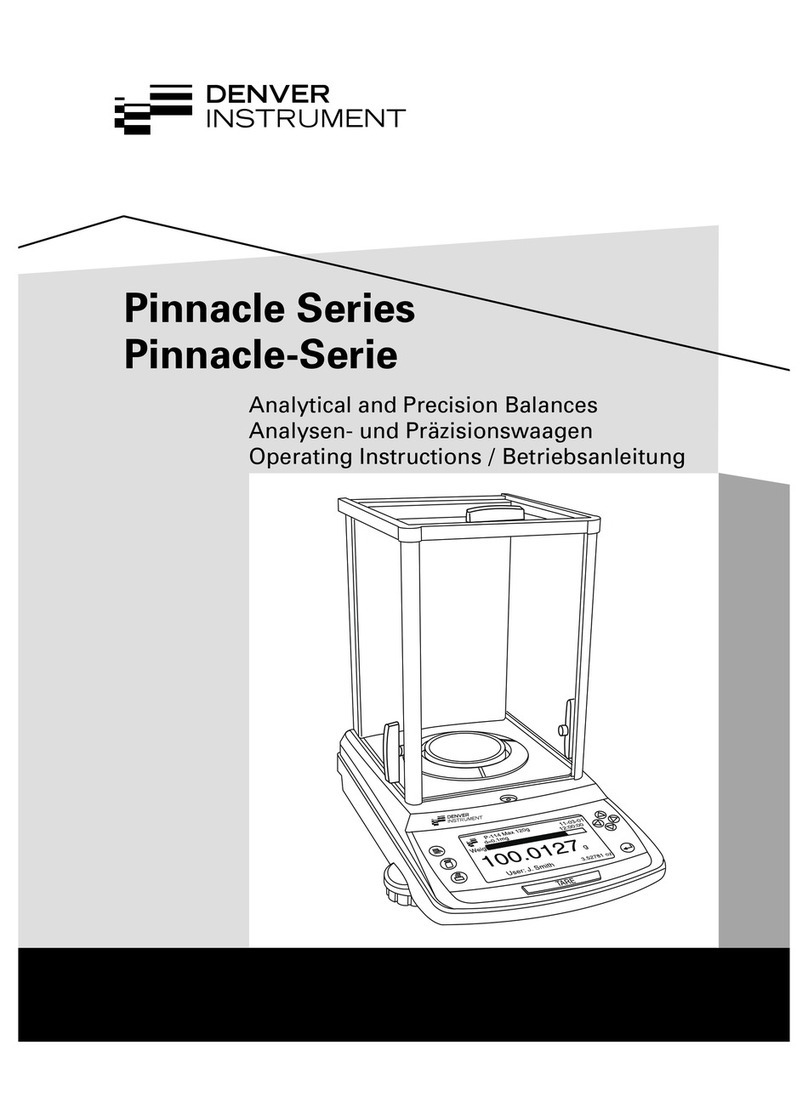
Denver Instrument
Denver Instrument P-114 User manual
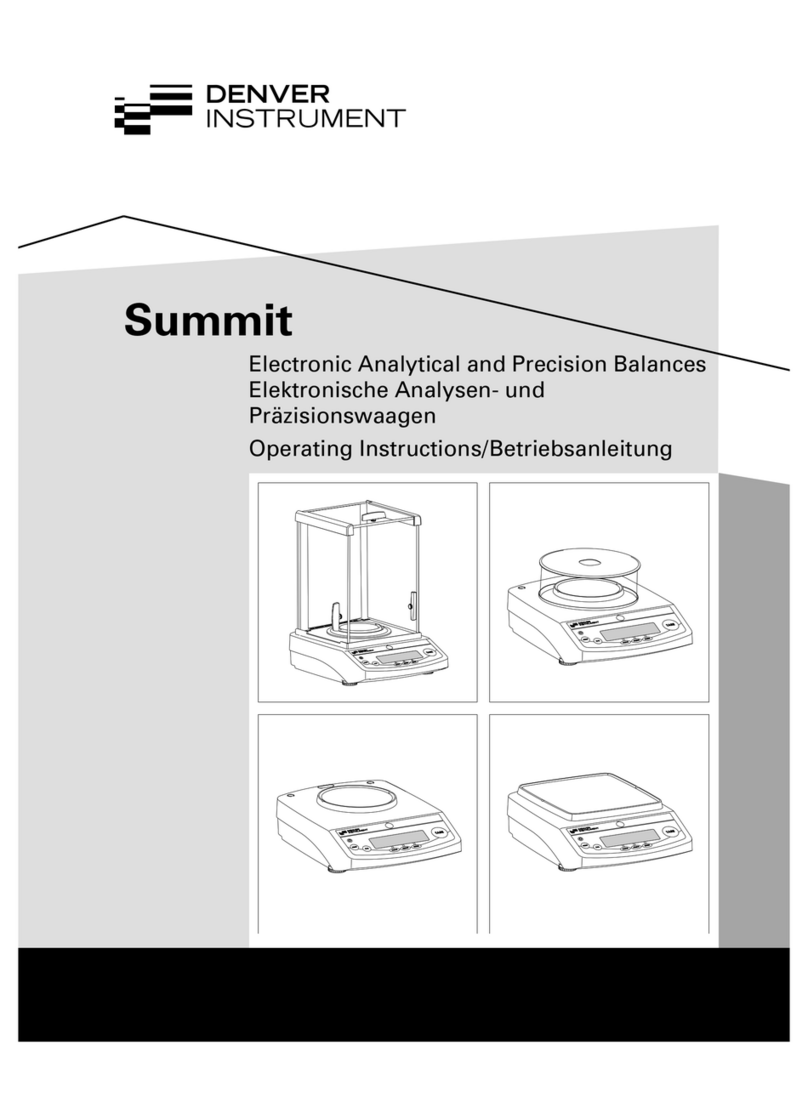
Denver Instrument
Denver Instrument Summit User manual
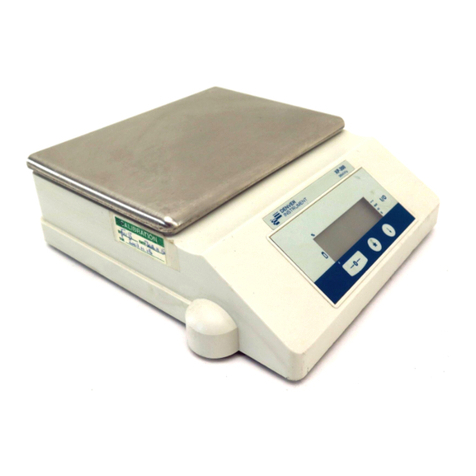
Denver Instrument
Denver Instrument XP Series User manual
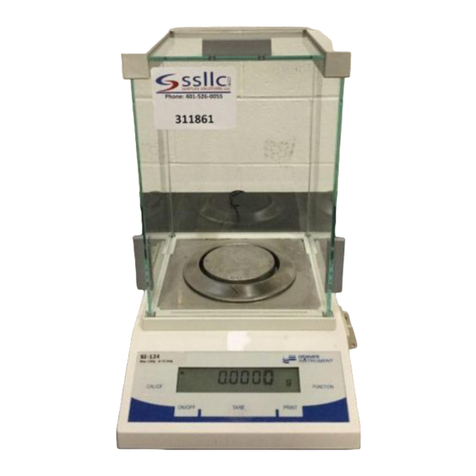
Denver Instrument
Denver Instrument TB Series User manual

Denver Instrument
Denver Instrument PK-Series User manual

Denver Instrument
Denver Instrument DA Series User manual
